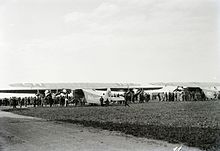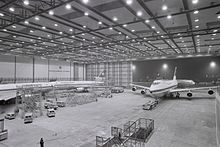Balair
Balair was the name of several Swiss airlines . The first existed from 1925 to 1930, the second from 1953, from 1972 to 1993 or 1995 as a Swissair subsidiary, and another from 1997 to 2001 again as a Swissair subsidiary.
history
The first Balair from 1925
In 1925, Alphonse Ehinger (President), Paul Joerin, Robert Labhardt, Friedrich Schwarz and Rudolf Speich founded Basler Luftverkehrs-Aktiengesellschaft on September 2nd . The company started air traffic with a Fokker Grulich F.II bought by the Badisch-Pfälzische Luftverkehrs AG with pilots from that company. The first line ran from Basel to Freiburg im Breisgau and Mannheim in October 1925 . On April 1, 1926, the company was renamed Basler Luftverkehrs AG , or Balair for short, using the French name of the city of Basel , Bâle. Balz Zimmermann became the company's director. Balair grew rapidly - in 1929, the Basel-Sternenfeld airfield was (at that time still) the largest airfield in Switzerland, and was directly served by nine routes (including from La Chaux-de-Fonds , Zurich , Geneva - Lyon or Karlsruhe and Frankfurt am Main ).
Because of the global economic crisis, Balair from Basel and Ad Astra Aero from Zurich had to merge to form Swissair on January 1, 1931, under pressure from the Federal Aviation Office . The larger Balair took over the older Ad Astra. The fact that Zurich was chosen as the headquarters of Swissair was due to the better economic prospects.
During its existence, the Balair flew over 18,000 passengers, 320 tons of freight and a good 143 tons of mail. It was only flown in the summer half of the year. It was financed by a. with federal subsidies and mail transport for the Swiss PTT companies.
The second Balair in the 1950s to 1980s

The second Balair was founded in January 1953. The Basel electorate approved the establishment of a public limited company on October 5, 1952. Hans Peter Tschudin was elected as the first president.
In the first few years, Balair concentrated on flight training and aircraft maintenance as well as handling the Swissair aircraft at Basel-Mulhouse airfield. 1957 the entry into the charter business took place with two Vickers 610 Vikings . In 1959, Swissair acquired a 40 percent stake in Balair. The fleet was increased by two Swissair DC-4s . Balair also used Boeing C-97 Stratofreighter for Biafra aid from the Joint Church Aid organization .
In 1965, planes were used for the first time for Swissair on scheduled services to Bern and Basel, after Swissair had taken its DC-3 out of service; A Fokker F-27 rented from Swissair was used on the Basel-Geneva-Bern-Zurich routes as well as from Basel to Frankfurt and London. At that time the fleet consisted of three DC-6Bs, two Fokker and the DC-4 freighter used for Swissair on the route to London.
In 1972 Swissair acquired the majority stake and in 1979 the fleet consisted of a DC-6 , a DC-9 , two DC-8 and a newly added DC-10 (registration number HB-IHK).
Destinations during the winter time included Mombasa , Rio de Janeiro , Colombo ( Sri Lanka ), New York and Los Angeles . The Balair aircraft were very often in crisis areas on behalf of the ICRC . A Fokker F-27 was operated on behalf of the United Nations . With the DC-6 HB-IBS, Balair had the last four-engine propliner in Switzerland. The machine was sold to Canada and flies there as a fire-fighting aircraft.
By concentrating on long-haul routes, however, the parent company Swissair was unable to benefit as desired, for example the company was unable to relieve Swissair if necessary due to excessive utilization of its aircraft. The airline, conceived as a small Swissair, also did not work efficiently.
Balair CTA in the 1990s

Later, Swissair operated charter flights under the name Balair, and in 1993 the two charter subsidiaries Balair and CTA - Compagnie de Transport Aérien , based in Geneva, were merged to form Balair-CTA. For political reasons, the company's legal domicile remained in Geneva and the accounting department in Basel, while the operational base was relocated to Zurich.
Despite restructuring and mass layoffs, the Swissair charter business could not be brought into profitability. In 1995 operations were stopped. The short-haul routes were transferred to Crossair , the long-haul routes to Swissair. In 1997 the charter business was outsourced again, and as of November 1, 1997, the Balair-CTA flew as a subsidiary of Swissair.
The new Balair in the late 1990s
The combination of charter and scheduled traffic did not prove itself, however, and so a charter subsidiary of Swissair was founded again in 1997, which operated under the old brand name Balair. Exclusively for the tour operator Hotelplan and their subsidiaries ESCO-Reisen and M-Travel, two Boeing 757-200s were operated on medium and short-haul routes , the lessee of which was Hotelplan itself. In addition, Balair had two Boeing 767-300s for long-haul routes.
The new Balair also got caught up in the whirlpool of the Swissair crisis after its grounding . The last Balair flight landed in Zurich on October 5, 2001. While the Boeing 767s were being returned to the lessors, Hotelplan transferred their own Boeing 757s to Belair Airlines, which was founded as a rescue company .
Incidents
- In its first business year, the Fokker F.III , which was taken over by KLM on April 10, 1926, suffered a total loss with enrollment CH-156 in Nyon. The Fokker F.VIIa , which was procured as a replacement in 1927, is now in the Museum of Transport in Lucerne.
- In 1928 the Fokker F.III, registered as CH-153, had an accident in Lausanne because of an engine breakdown, like the other aircraft of this type taken over from KLM (ex H-NABJ) on April 10, 1926.
- On October 30, 1930, during a flight of the Fokker F.VIIb-3m with the matriculation CH-161 while searching for Essen airfield in the fog, a collision with a high chimney occurred. The first accident reports assumed a collision with a tree. The aircraft was on the Amsterdam-Frankfurt-Basel-Geneva route and left Amsterdam as scheduled at 9:20 am. Two Dutch and one Swiss passengers were unharmed and continued their journey by train. Some of the pilots, mechanics and radio operators were seriously injured.
- On May 15, 1960, the Douglas DC-4 crashed with the HB-ILA enrollment in Sudan . The aircraft had been taken over by Swissair on May 29, 1959.
See also
literature
- Walter Borner: Balair - the history of the Swiss charter company. AS Buchkonzept AG, Zurich 1991.
- Benedikt Meyer: In flight. Swiss airlines and their passengers, 1919–2002. Chronos, Zurich 2014, ISBN 978-3-0340-1238-6 .
- Trudi von Fellenberg-Bitzi , BALAIR - When flying was still flying, AS-Verlag & Buchkonzept AG, Zurich 2017, ISBN 978-3-906055-73-2
Individual evidence
- ↑ a b c Borner, 1991, p. 8
- ↑ Meyer, 2014, p. 38
- ↑ Meyer, 2014, p. 123
- ↑ Meyer, 2014, p. 209
- ^ Meyer, p. 210
- ↑ Meyer, 2014, p. 265
- ↑ Meyer, 2014, p. 298
- ↑ Borner, 1991, appendix
- ^ On the emergency landing of "CH 161" , NZZ , October 31, 1930, page b2
- ↑ Borner, 1991, appendix
Web links
- Balair AG holdings in the Swiss Economic Archives


